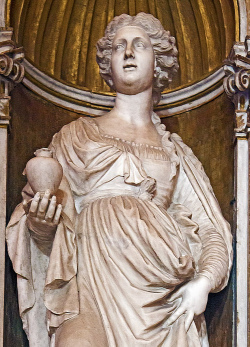Jesus was resurrected by God the Father near sunset on Saturday, April 8 in 30 A.D. His resurrection at this precise time was a fulfillment of his own prophecy (Matthew 12:40). Roughly twelve hours later he miraculous appears, in human form, to Mary Magdalene near his tomb. It is during this startling encounter that Jesus seems to forbid Mary from touching him, an act that has baffled Christians for many years.
Jesus saith unto her, Mary. She turned herself, and saith unto him, Rabboni; which is to say, Master.
Jesus saith unto her, Touch me not; for I am not yet ascended to my Father: but go to my brethren, and say unto them, I ascend unto my Father, and your Father; and to my God, and your God (John 20:16 - 17, KJV).
Translation Differences
Some Bible translations of John 20:17, such as the venerable King James shown above, state that Jesus told Mary to "touch me not." This implies he commanded her not to touch him at all.

Other translations of John 20:17, however, give the distinct impression that Mary was in the process of touching Jesus when she was told to stop.
Jesus said to her, "Do not cling to Me, for I have not yet ascended to My Father . . ." (NKJV).
Jesus said, "Do not hold on to me, for I have not yet returned to the Father . . ." (NIV, see also the HCSB, NASB and other translations of John 20:17).
What, then, is the truth regarding Mary Magdalene's interaction with Jesus?
Clarifying Confusion
Two Biblical commentaries pinpoint the reason for the confusion surrounding John 20:17 and the true meaning of the verse.
"Touch me not - is better translated, "Stop clinging to me." The Greek verb underlying "clinging" is a present imperative. The action had already begun when Jesus told Mary, "Stop clinging to me."
"He (Jesus) was not preventing Mary from touching him (which would be the meaning if an aorist imperative had been used)." (New Commentary on the Whole Bible on John 20:17).
"The verb translated 'Touch me not' (KJV) is a present imperative and is probably better translated 'Stop clinging to me' (NASB).
"The reason she must release him is that she must go testify for him in the short time remaining in view of his coming ascension . . . " (Bible Background Commentary on John 20:17).
Conclusion
Mary Magdalene, grieving at the time (John 20:11), couldn't help but touch Jesus when he revealed to her he was alive. The Lord, however, had to abruptly end her show of affection as his appearance before the Father was quickly arriving. He also wanted her to inform the disciples of his ascension before it took place.
Additionally, Mary's touching of Jesus' physical body would not have adversely affected his appearance before the Father in heaven. This is because his appearance would be with the same type of glorified spirit body he possessed, as a member of the Godhead, before he became flesh (see Hebrews 1:3, 8).